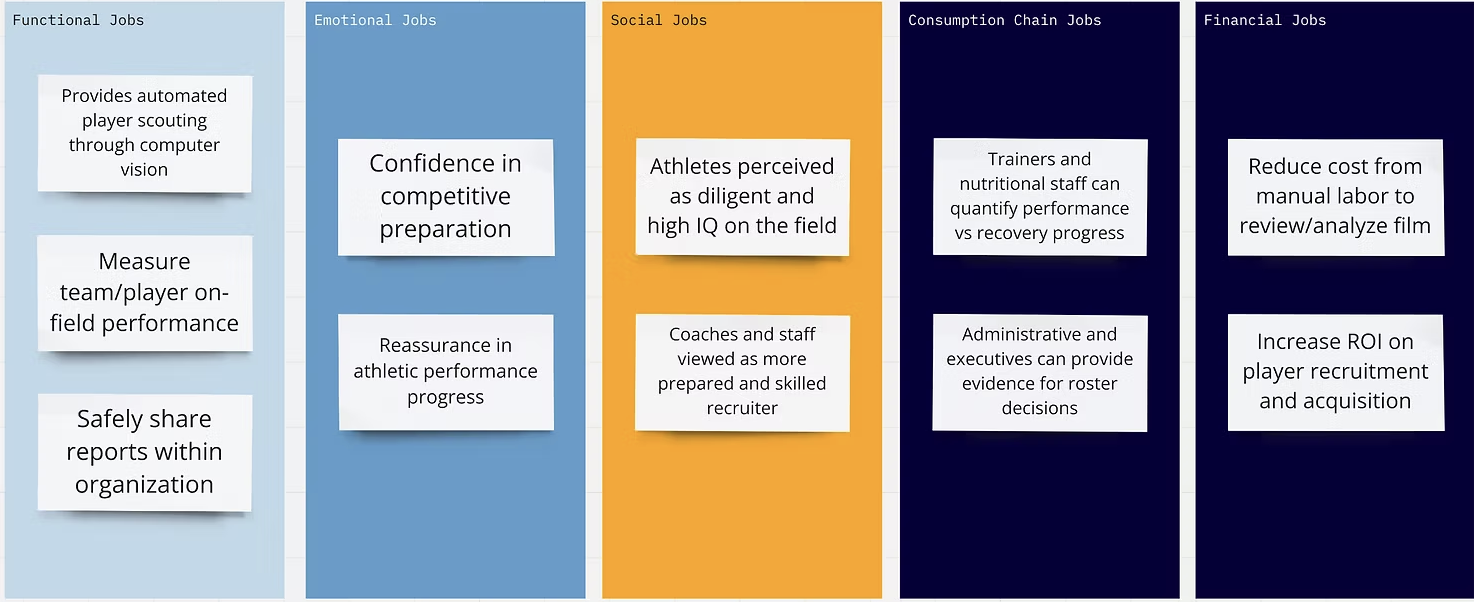Athlete Insights (AI-Powered Sports Analytics)
🔹 Outcome: Identified market gap for automated performance insights in sports using AI.
🔹 Role & Skills: Led product discovery (market research, feasibility), designed mock UX flows, scoped CV/ML approach.
🔹 Key Strengths Shown: Product strategy, market validation, feasibility assessment, applied AI framing.
Lessons Learned:
Misread User Value: Coaches didn't want less film review, they wanted better insights during review. Pivoted from "replacing analysis" to "augmenting decisions."
Complexity ≠ Value: 22-player tracking overwhelmed users. Simpler metrics for 2-3 key players proved more valuable. Less can be more.
B2B Focus Validated Market Fit: Initially considered direct-to-athlete pricing but early research confirmed coaches control team budgets and make technology decisions. Targeting programs at $1,200/team/year aligned with actual buying authority and provided sustainable unit economics.
1. Identifying the Problem: A Time-Consuming, Manual Process
Approach
To validate the problem, I conducted user validation, competitive analysis, and applied the Jobs to Be Done (JTBD) framework to define key pain points and opportunities.
User Pain Points
90% of coaches use film analysis, but 70% lack time for in-depth review.
Manual breakdowns take 4+ hours per game, delaying real-time strategy.
Existing tools lack AI automation, requiring manual tagging & analysis.
Competitive Gaps
Hudl & Synergy provide raw footage, but no real-time insights.
Designed for team film study, limiting individual player development.
Lack of automation keeps analysis reactive, not proactive.
JBTD
Functional: Automate film review, measure performance, generate reports.
Emotional: Build confidence in preparation and player development.
Social: Help athletes showcase skills; position coaches as strong recruiters.
Financial: Reduce manual labor costs and improve ROI on scouting.
Opportunity
Coaches & athletes need real-time, AI-powered insights, not just film.
An AI-driven tool could automate film review, reducing time by 80%.
2. Validating Feasibility & Aligning with Business Goals
Technology Feasibility
Researched computer vision models for tracking player movements & game events.
Benchmarked AI applications in fitness & gaming to validate real-world use cases.
Identified gaps in Hudl & Synergy, which lack automated play detection.
Market Demand
AI-powered sports analytics projected to exceed $5B by 2028.
70% of coaches struggle with time constraints, reinforcing demand for automation.
Growth in wearable tech & real-time analytics signals industry-wide adoption.
Strategic Fit
Bridges a major gap in amateur & collegiate sports, where AI solutions are limited.
Scalable beyond initial use case—expands into multi-sport analysis & live insights.
Opportunity
AI-driven film analysis can cut review time by 80%, making pro-level insights accessible at all levels.
3. Defining the MVP: AI-Powered Insights for Coaches & Athletes
Empathy-Driven Insights
To refine feature prioritization and UX, I applied the Empathy Map framework, analyzing how coaches, athletes, and recruiters engage with game film.
Think & Feel: Coaches worry about roster decisions & data reliability; athletes lack clear, actionable feedback.
See: Reports exist but lack quantifiable performance insights; film uploads have no automated breakdowns.
Hear: Coaches get team updates, but no automated performance validation; athletes hear praise but lack metrics.
Say & Do: Coaches and athletes spend hours on manual film review, making real-time decision-making difficult.
MVP Solution: Addressing Core Pain Points
By reducing manual review time and improving decision-making efficiency, I structured an MVP that delivers maximum impact with minimal complexity.
MVP Features
Automated Play Breakdown: AI detects & tags key game moments (shots, passes, defensive plays), reducing manual review time by 80%.
Player Performance Metrics: Tracks speed, agility, reaction time, and fatigue, offering quantifiable development insights.
Instant Game Recaps: Generates digestible summaries for faster strategy adjustments during and after games.
Cross-Functional Execution (Hypothetical Approach)
Engineering: Assessed AI feasibility for automated tagging & tracking.
Design: Defined UX flows for intuitive adoption & usability.
Go-To-Market Strategy: Focused on early adoption among coaches & teams.
4. Roadmap & Prioritization
To drive adoption and scale efficiently, I structured the roadmap using the AARRR framework (Acquisition, Activation, Retention, Revenue, Referrals). This approach ensured clear prioritization, success metrics, and a validated go-to-market strategy.
Phase 1: Research & Validation (Acquisition & Activation)
Goal: Validate user demand, technical feasibility, and market fit.
Defined target users (coaches, athletes, recruiters).
Researched AI feasibility for real-time play breakdown and player tracking.
Benchmarked against Hudl, Synergy, and emerging AI sports analytics tools.
Conducted user interviews and applied JTBD analysis to map pain points.
AARRR Focus: Ensured early traction by confirming market demand before development.
Phase 2: Prototype & User Testing (Activation & Retention)
Goal: Test usability, refine MVP scope, and optimize for adoption (Hypothetical Execution).
Built a clickable prototype to validate UX/UI flow with coaches and athletes.
Measured onboarding experience and feature adoption through feedback loops.
Prioritized high-impact features based on user retention signals.
Improved AI accuracy to reduce false positives in play detection.
AARRR Focus: Ensured users experience immediate value, reducing churn risk.
Phase 3: MVP Launch & Feedback Iteration (Retention & Revenue)
Goal: Deploy MVP, measure engagement, and iterate based on insights (Hypothetical Execution).
Pilot launch with early adopters, measuring success by:
80% reduction in manual review time.
Increased athlete engagement via personalized insights.
Improved coaching efficiency with real-time strategy adjustments.
Integrated automated reporting & AI-driven analytics.
Established a continuous feedback loop, refining features based on user data.
AARRR Focus: Strengthened retention and product stickiness for long-term usage.
Phase 4: Scaling & Monetization (Revenue & Referrals)
Goal: Expand adoption, establish partnerships, and introduce monetization (Hypothetical Execution).
Partnered with sports tech companies & training academies to drive adoption.
Developed a subscription-based SaaS model with tiered pricing.
Incentivized referrals & organic growth through early adopters.
AARRR Focus: Monetization through subscriptions & B2B partnerships, with referral loops fueling organic expansion.
Key Takeaways: How This Showcases My Product Thinking
User-Centered Discovery
Grounded in real user pain points, validated through research and interviews.
Data-Driven Decision-Making
Leveraged market insights, AI feasibility, and competitive analysis.
Strategic Execution
Balanced user needs, technical feasibility, and business viability in MVP design.
Structured Roadmap
Prioritized development with clear success metrics and scalable growth strategy.


